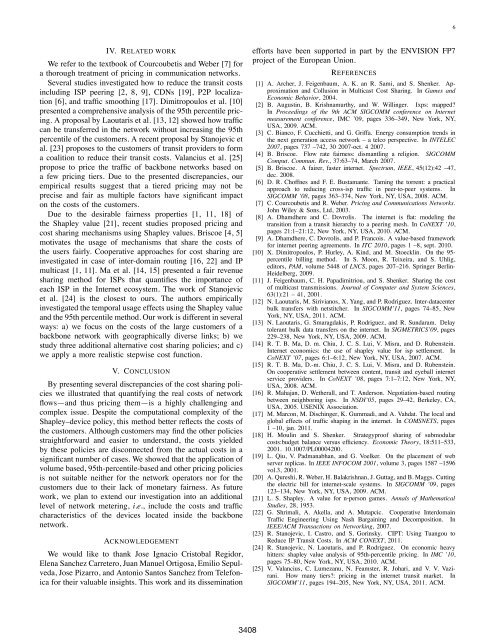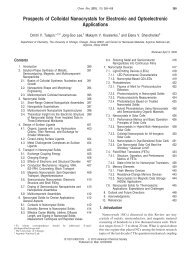Sharing the Cost of Backbone Networks - Computer Science
Sharing the Cost of Backbone Networks - Computer Science
Sharing the Cost of Backbone Networks - Computer Science
Create successful ePaper yourself
Turn your PDF publications into a flip-book with our unique Google optimized e-Paper software.
6<br />
IV. RELATED WORK<br />
We refer to <strong>the</strong> textbook <strong>of</strong> Courcoubetis and Weber [7] for<br />
athoroughtreatment<strong>of</strong>pricingincommunicationnetworks.<br />
Several studies investigated how to reduce <strong>the</strong> transit costs<br />
including ISP peering [2, 8, 9], CDNs [19], P2P localization<br />
[6], and traffic smoothing [17]. Dimitropoulos et al. [10]<br />
presented a comprehensive analysis <strong>of</strong> <strong>the</strong> 95th percentile pricing.<br />
A proposal by Laoutaris et al. [13, 12] showed how traffic<br />
can be transferred in <strong>the</strong> network without increasing <strong>the</strong> 95th<br />
percentile <strong>of</strong> <strong>the</strong> customers. A recent proposal by Stanojevicet<br />
al. [23] proposes to <strong>the</strong> customers <strong>of</strong> transit providers to form<br />
acoalitiontoreduce<strong>the</strong>irtransitcosts.Valanciusetal.[25]<br />
propose to price <strong>the</strong> traffic <strong>of</strong> backbone networks based on<br />
afewpricingtiers.Dueto<strong>the</strong>presenteddiscrepancies,our<br />
empirical results suggest that a tiered pricing may not be<br />
precise and fair as multiple factors have significant impact<br />
on <strong>the</strong> costs <strong>of</strong> <strong>the</strong> customers.<br />
Due to <strong>the</strong> desirable fairness properties [1, 11, 18] <strong>of</strong><br />
<strong>the</strong> Shapley value [21], recent studies proposed pricing and<br />
cost sharing mechanisms using Shapley values. Briscoe [4, 5]<br />
motivates <strong>the</strong> usage <strong>of</strong> mechanisms that share <strong>the</strong> costs <strong>of</strong><br />
<strong>the</strong> users fairly. Cooperative approaches for cost sharing are<br />
investigated in case <strong>of</strong> inter-domain routing [16, 22] and IP<br />
multicast [1, 11]. Ma et al. [14, 15] presented a fair revenue<br />
sharing method for ISPs that quantifies <strong>the</strong> importance <strong>of</strong><br />
each ISP in <strong>the</strong> Internet ecosystem. The work <strong>of</strong> Stanojevic<br />
et al. [24] is <strong>the</strong> closest to ours. The authors empirically<br />
investigated <strong>the</strong> temporal usage effects using <strong>the</strong> Shapley value<br />
and <strong>the</strong> 95th percentile method. Our work is different in several<br />
ways: a) we focus on <strong>the</strong> costs <strong>of</strong> <strong>the</strong> large customers <strong>of</strong> a<br />
backbone network with geographically diverse links; b) we<br />
study three additional alternative cost sharing policies; and c)<br />
we apply a more realistic stepwise cost function.<br />
V. CONCLUSION<br />
By presenting several discrepancies <strong>of</strong> <strong>the</strong> cost sharing policies<br />
we illustrated that quantifying <strong>the</strong> real costs <strong>of</strong> network<br />
flows—and thus pricing <strong>the</strong>m—is a highly challenging and<br />
complex issue. Despite <strong>the</strong> computational complexity <strong>of</strong> <strong>the</strong><br />
Shapley–device policy, this method better reflects <strong>the</strong> costs <strong>of</strong><br />
<strong>the</strong> customers. Although customers may find <strong>the</strong> o<strong>the</strong>r policies<br />
straightforward and easier to understand, <strong>the</strong> costs yielded<br />
by <strong>the</strong>se policies are disconnected from <strong>the</strong> actual costs in a<br />
significant number <strong>of</strong> cases. We showed that <strong>the</strong> application <strong>of</strong><br />
volume based, 95th-percentile-based and o<strong>the</strong>r pricing policies<br />
is not suitable nei<strong>the</strong>r for <strong>the</strong> network operators nor for <strong>the</strong><br />
customers due to <strong>the</strong>ir lack <strong>of</strong> monetary fairness. As future<br />
work, we plan to extend our investigation into an additional<br />
level <strong>of</strong> network metering, i.e., include<strong>the</strong>costsandtraffic<br />
characteristics <strong>of</strong> <strong>the</strong> devices located inside <strong>the</strong> backbone<br />
network.<br />
ACKNOWLEDGEMENT<br />
We would like to thank Jose Ignacio Cristobal Regidor,<br />
Elena Sanchez Carretero, Juan Manuel Ortigosa, Emilio Sepulveda,<br />
Jose Pizarro, and Antonio Santos Sanchez from Telefonica<br />
for <strong>the</strong>ir valuable insights. This work and its dissemination<br />
efforts have been supported in part by <strong>the</strong> ENVISION FP7<br />
project <strong>of</strong> <strong>the</strong> European Union.<br />
REFERENCES<br />
[1] A. Archer, J. Feigenbaum, A. K. an R. Sami, and S. Shenker. Approximation<br />
and Collusion in Multicast <strong>Cost</strong> <strong>Sharing</strong>. In Games and<br />
Economic Behavior, 2004.<br />
[2] B. Augustin, B. Krishnamurthy, and W. Willinger. Ixps: mapped?<br />
In Proceedings <strong>of</strong> <strong>the</strong> 9th ACM SIGCOMM conference on Internet<br />
measurement conference, IMC ’09, pages 336–349, New York, NY,<br />
USA, 2009. ACM.<br />
[3] C. Bianco, F. Cucchietti, and G. Griffa. Energy consumption trends in<br />
<strong>the</strong> next generation access network – a telco perspective. In INTELEC<br />
2007, pages737–742,302007-oct.42007.<br />
[4] B. Briscoe. Flow rate fairness: dismantling a religion. SIGCOMM<br />
Comput. Commun. Rev., 37:63–74,March2007.<br />
[5] B. Briscoe. A fairer, faster internet. Spectrum, IEEE, 45(12):42–47,<br />
dec. 2008.<br />
[6] D. R. Ch<strong>of</strong>fnes and F. E. Bustamante. Taming <strong>the</strong> torrent: a practical<br />
approach to reducing cross-isp traffic in peer-to-peer systems. In<br />
SIGCOMM ’08, pages363–374,NewYork,NY,USA,2008.ACM.<br />
[7] C. Courcoubetis and R. Weber. Pricing and Communications <strong>Networks</strong>.<br />
John Wiley & Sons, Ltd, 2003.<br />
[8] A. Dhamdhere and C. Dovrolis. The internet is flat: modeling <strong>the</strong><br />
transition from a transit hierarchy to a peering mesh. In CoNEXT ’10,<br />
pages 21:1–21:12, New York, NY, USA, 2010. ACM.<br />
[9] A. Dhamdhere, C. Dovrolis, and P. Francois. A value-based framework<br />
for internet peering agreements. In ITC 2010, pages1–8,sept.2010.<br />
[10] X. Dimitropoulos, P. Hurley, A. Kind, and M. Stoecklin. On <strong>the</strong> 95-<br />
percentile billing method. In S. Moon, R. Teixeira, and S. Uhlig,<br />
editors, PAM,volume5448<strong>of</strong>LNCS, pages207–216.SpringerBerlin-<br />
Heidelberg, 2009.<br />
[11] J. Feigenbaum, C. H. Papadimitriou, and S. Shenker. <strong>Sharing</strong> <strong>the</strong> cost<br />
<strong>of</strong> multicast transmissions. Journal <strong>of</strong> <strong>Computer</strong> and System <strong>Science</strong>s,<br />
63(1):21 – 41, 2001.<br />
[12] N. Laoutaris, M. Sirivianos, X. Yang, and P. Rodriguez. Inter-datacenter<br />
bulk transfers with netstitcher. In SIGCOMM’11, pages74–85,New<br />
York, NY, USA, 2011. ACM.<br />
[13] N. Laoutaris, G. Smaragdakis, P. Rodriguez, and R. Sundaram. Delay<br />
tolerant bulk data transfers on <strong>the</strong> internet. In SIGMETRICS’09, pages<br />
229–238, New York, NY, USA, 2009. ACM.<br />
[14] R. T. B. Ma, D. m. Chiu, J. C. S. Lui, V. Misra, and D. Rubenstein.<br />
Internet economics: <strong>the</strong> use <strong>of</strong> shapley value for isp settlement. In<br />
CoNEXT ’07, pages6:1–6:12,NewYork,NY,USA,2007.ACM.<br />
[15] R. T. B. Ma, D.-m. Chiu, J. C. S. Lui, V. Misra, and D. Rubenstein.<br />
On cooperative settlement between content, transit and eyeball internet<br />
service providers. In CoNEXT ’08, pages7:1–7:12,NewYork,NY,<br />
USA, 2008. ACM.<br />
[16] R. Mahajan, D. We<strong>the</strong>rall, and T. Anderson. Negotiation-based routing<br />
between neighboring isps. In NSDI’05, pages 29–42, Berkeley, CA,<br />
USA, 2005. USENIX Association.<br />
[17] M. Marcon, M. Dischinger, K. Gummadi, and A. Vahdat. The local and<br />
global effects <strong>of</strong> traffic shaping in <strong>the</strong> internet. In COMSNETS, pages<br />
1–10,jan.2011.<br />
[18] H. Moulin and S. Shenker. Strategypro<strong>of</strong> sharing <strong>of</strong> submodular<br />
costs:budget balance versus efficiency. Economic Theory, 18:511–533,<br />
2001. 10.1007/PL00004200.<br />
[19] L. Qiu, V. Padmanabhan, and G. Voelker. On <strong>the</strong> placement <strong>of</strong> web<br />
server replicas. In IEEE INFOCOM 2001, volume3,pages1587–1596<br />
vol.3, 2001.<br />
[20] A. Qureshi, R. Weber, H. Balakrishnan, J. Guttag, and B. Maggs. Cutting<br />
<strong>the</strong> electric bill for internet-scale systems. In SIGCOMM ’09, pages<br />
123–134, New York, NY, USA, 2009. ACM.<br />
[21] L. S. Shapley. A value for n-person games. Annals <strong>of</strong> Ma<strong>the</strong>matical<br />
Studies, 28,1953.<br />
[22] G. Shrimali, A. Akella, and A. Mutapcic. Cooperative Interdomain<br />
Traffic Engineering Using Nash Bargaining and Decomposition. In<br />
IEEE/ACM Transactions on Networking, 2007.<br />
[23] R. Stanojevic, I. Castro, and S. Gorinsky. CIPT: Using Tuangou to<br />
Reduce IP Transit <strong>Cost</strong>s. In ACM CONEXT, 2011.<br />
[24] R. Stanojevic, N. Laoutaris, and P. Rodriguez. On economic heavy<br />
hitters: shapley value analysis <strong>of</strong> 95th-percentile pricing. In IMC ’10,<br />
pages 75–80, New York, NY, USA, 2010. ACM.<br />
[25] V. Valancius, C. Lumezanu, N. Feamster, R. Johari, and V. V.Vazirani.<br />
How many tiers?: pricing in <strong>the</strong> internet transit market. In<br />
SIGCOMM’11, pages194–205,NewYork,NY,USA,2011.ACM.<br />
3408
















